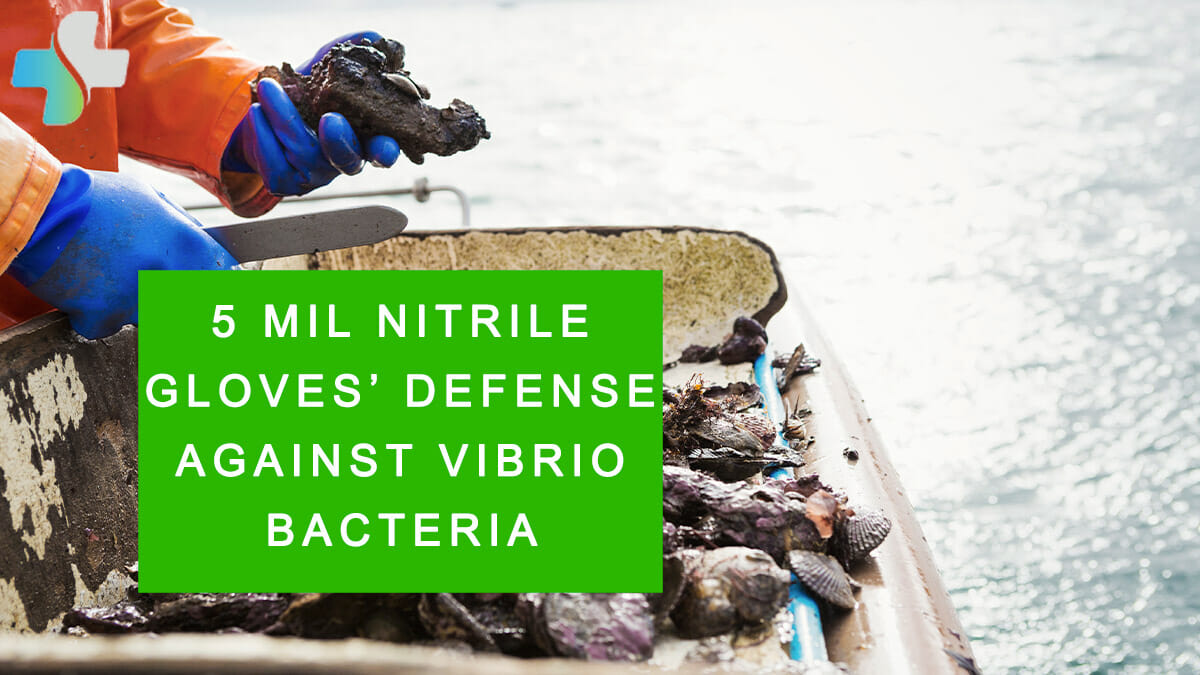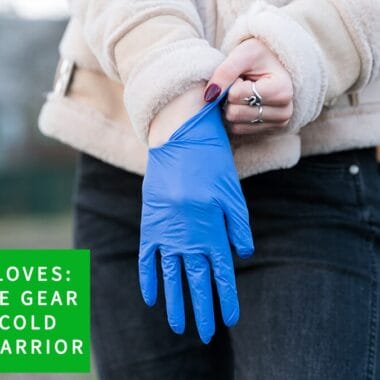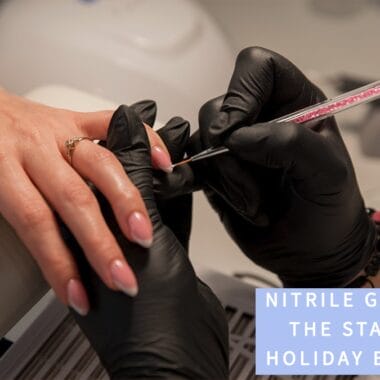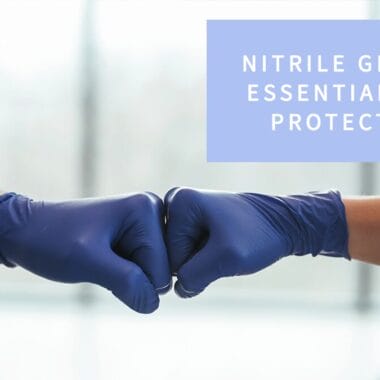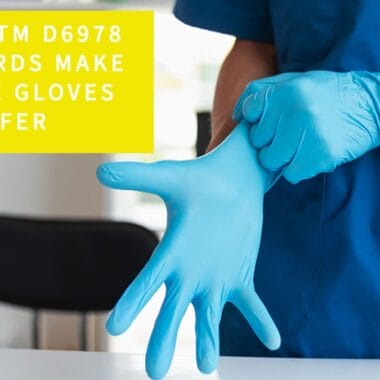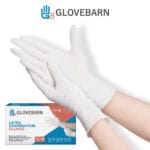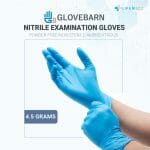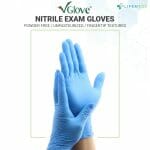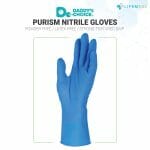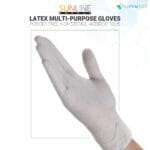Wearing personal protective equipment (PPE) gloves to protect against germs, disease, and infections is crucial for human health and safety. Protecting against infections like Vibrio parahaemolyticus requires a reliable pair of PPE gloves—and nitrile gloves offer just that.
What is Vibrio parahaemolyticus?
Vibrio parahaemolyticus is a Gram-negative, halophilic bacterium commonly found in marine, coastal, and estuarine settings. With its curved, rod-like shape and a polar flagellum, this motile organism thrives in salty environments, typically associating with marine habitats. Vibrio parahaemolyticus, a species of Vibrio that can cause vibriosis, is a primary cause of seafood-borne gastroenteritis illness in humans. In more severe cases, Vibrio parahaemolyticus infection can cause sepsis. When humans consume food or water contaminated by Vibrio, they can experience symptoms such as diarrhea, vomiting, abdominal cramps, nausea, fever, and headache. Vibrio symptoms generally manifest within 24 hours of ingestion and persist for 2-3 days. Vibrio bacteria poses a risk for wound infections if an open wound comes into direct contact with contaminated seawater.
Although commonly caused by other Vibrio species, Vibrio parahaemolyticus infections can escalate to severe conditions like necrotizing fasciitis. The bacterium’s prevalence in seafood, particularly shellfish like oysters, intensifies during warm temperatures and subsides in colder conditions, so Vibrio infections are prevalent in the summertime. Proper seafood cooking can effectively eliminate the hazard of V. parahaemolyticus from seafood. Vibrio prevention strategies include cooking seafood thoroughly, safely handling food, and avoiding raw seafood for those at higher risk.
Can Wearing Gloves Prevent Vibrio Bacteria?
Wearing PPE gloves can be an effective barrier against Vibrio bacteria, particularly when handling potentially contaminated materials or environments. In the seafood industry, disposable gloves can be especially beneficial for food handlers in direct contact with raw shellfish, reducing the risk of skin exposure to Vibrio bacteria. For open cuts or hand wounds, water-resistant gloves offer protection against Vibrio infection when in contact with tainted water or seafood. Using gloves helps minimize the risk of cross-contamination, preventing the transfer of bacteria to other people, surfaces, or food in kitchen settings.
Before putting on a pair of PPE gloves, it’s crucial to ensure no tears or holes in the gloves. The proper donning and doffing of gloves is essential for avoiding self-contamination and cross-contamination. Even with gloves, good hand hygiene, such as washing before and after glove use, remains foundational for preventing bacterial infections. Ultimately, chemical and tear-resistant gloves should be considered a safety component for proper food handling, cooking, and personal hygiene practices.
Using Nitrile Gloves as a Preventative Measure Against Vibrio parahaemolyticus
5 mil nitrile gloves are among the best glove choices for many applications, especially in medical and industrial settings. Nitrile is made from synthetic rubber, which offers several advantages over latex and vinyl gloves. Nitrile gloves are inherently chemical resistant, making them a preferred choice for working with hazardous materials or in environments exposed to harmful substances. Their thick, cut-resistant material makes them less likely to tear or puncture, providing strong and reliable glove protection.
Additionally, nitrile gloves are an excellent alternative for individuals with latex allergies or sensitivities, eliminating the risk of allergic reactions at work or home. While some individuals may have allergic reactions to nitrile material, it’s less common than latex. 5 mil nitrile gloves offer a snug fit, allowing for dexterity and tactile sensitivity, fundamental for tasks requiring precision. Nitrile gloves have a longer shelf life than latex gloves, making them a cost-effective glove option for many industries. The combination of durability, chemical resistance, and tactile performance makes nitrile gloves a top choice for various applications.
Nitrile’s Barrier Protection Against Contaminants
Nitrile is a synthetic rubber made from a copolymer of acrylonitrile and butadiene. It is a preferred glove choice in many clinical and laboratory settings due to its resistance to various chemicals, oils, and other substances. This material acts as a barrier, preventing direct contact with potentially contaminated surfaces and materials. The thickness of a glove plays a role in its durability, tactile sensitivity, and protection. 5 mil is roughly 0.005 inches and is moderately thick for disposable gloves. This glove thickness perfectly combines durability and tactile sensitivity during tasks. It offers adequate protection against contaminants in most everyday tasks, although thicker nitrile gloves might be preferred for tasks with a higher risk of tears or punctures.
Proper Use of PPE Gloves
Even the best gloves can only offer protection when used correctly. While nitrile gloves provide a barrier, they are not impenetrable. Extended chemical exposure or excessive physical stress can weaken or penetrate the glove. PPE gloves like nitrile function effectively as a protective barrier against bacterium like V. parahaemolyticus. It’s crucial to ensure that nitrile gloves are worn and removed correctly without contaminating the skin. Any glove that shows signs of damage, such as tears or holes, should not be worn and discarded immediately. Disposable gloves like nitrile should not be worn for extended periods and should be changed frequently, especially when switching tasks or when contamination is suspected.
Purchasing 5 mil Nitrile Gloves
When properly used, 5 mil nitrile gloves offer a reliable defense against contaminants, including bacteria like Vibrio parahaemolyticus. As the preferred glove choice in medical, industrial, and laboratory settings, nitrile gloves are essential for providing optimal hand protection and ensuring health and safety in the workplace. Nitrile’s durability and puncture resistance are crucial, especially in high-risk environments with hazardous materials or infectious agents. However, it’s critical to ensure their integrity and use them appropriately based on the risk associated with specific tasks. Pairing nitrile gloves with proper hygiene practices, like regular handwashing, is essential to maintain a comprehensive approach to safety and infection control. Purchasing high-quality, five-mil nitrile gloves is an economical investment for your PPE inventory, as it protects employees’ health and offers superior protection against a wide range of contaminants. Whether handling foods and chemicals or attending to patients, it’s crucial to prioritize safety by choosing nitrile gloves to defend against Vibrio parahaemolyticus.
References:
- National Library of Medicine, 2023. Vibrio parahaemolyticus Infection.
- Centers for Disease Control and Prevention, 2019. Vibrio Species Causing Vibriosis.
- Centers for Disease Control and Prevention, 2023. What is Sepsis?
- Centers for Disease Control and Prevention, 2019. Vibrio Species Causing Vibriosis: Symptoms.
- The Institute of Food and Agricultural Sciences (IFAS). Preventing Foodborne and Non-foodborne Illness: Vibrio parahaemolyticus.

